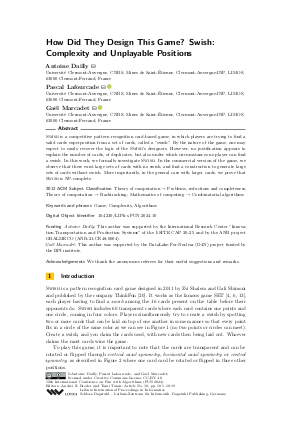How Did They Design This Game? Swish: Complexity and Unplayable Positions
Authors
Antoine Dailly,
Pascal Lafourcade  ,
Gaël Marcadet
,
Gaël Marcadet 
-
Part of:
Volume:
12th International Conference on Fun with Algorithms (FUN 2024)
Part of: Series: Leibniz International Proceedings in Informatics (LIPIcs)
Part of: Conference: International Conference on Fun with Algorithms (FUN) - License:
 Creative Commons Attribution 4.0 International license
Creative Commons Attribution 4.0 International license
- Publication Date: 2024-05-29
File

PDF
LIPIcs.FUN.2024.10.pdf
- Filesize: 0.77 MB
- 19 pages
Document Identifiers
Subject Classification
ACM Subject Classification
- Theory of computation → Problems, reductions and completeness
- Theory of computation → Backtracking
- Mathematics of computing → Combinatorial algorithms
Keywords
- Game
- Complexity
- Algorithms
Metrics
- Access Statistics
-
Total Accesses (updated on a weekly basis)
0PDF Downloads0Metadata Views
Abstract
Swish is a competitive pattern recognition card-based game, in which players are trying to find a valid cards superposition from a set of cards, called a "swish". By the nature of the game, one may expect to easily recover the logic of the Swish’s designers. However, no justification appears to explain the number of cards, of duplicates, but also under which circumstances no player can find a swish. In this work, we formally investigate Swish. In the commercial version of the game, we observe that there exist large sets of cards with no swish, and find a construction to generate large sets of cards without swish. More importantly, in the general case with larger cards, we prove that Swish is NP-complete.
Cite As Get BibTex
Antoine Dailly, Pascal Lafourcade, and Gaël Marcadet. How Did They Design This Game? Swish: Complexity and Unplayable Positions. In 12th International Conference on Fun with Algorithms (FUN 2024). Leibniz International Proceedings in Informatics (LIPIcs), Volume 291, pp. 10:1-10:19, Schloss Dagstuhl – Leibniz-Zentrum für Informatik (2024)
https://doi.org/10.4230/LIPIcs.FUN.2024.10
BibTex
@InProceedings{dailly_et_al:LIPIcs.FUN.2024.10,
author = {Dailly, Antoine and Lafourcade, Pascal and Marcadet, Ga\"{e}l},
title = {{How Did They Design This Game? Swish: Complexity and Unplayable Positions}},
booktitle = {12th International Conference on Fun with Algorithms (FUN 2024)},
pages = {10:1--10:19},
series = {Leibniz International Proceedings in Informatics (LIPIcs)},
ISBN = {978-3-95977-314-0},
ISSN = {1868-8969},
year = {2024},
volume = {291},
editor = {Broder, Andrei Z. and Tamir, Tami},
publisher = {Schloss Dagstuhl -- Leibniz-Zentrum f{\"u}r Informatik},
address = {Dagstuhl, Germany},
URL = {https://drops.dagstuhl.de/entities/document/10.4230/LIPIcs.FUN.2024.10},
URN = {urn:nbn:de:0030-drops-199185},
doi = {10.4230/LIPIcs.FUN.2024.10},
annote = {Keywords: Game, Complexity, Algorithms}
}
Author Details
- Université Clermont-Auvergne, CNRS, Mines de Saint-Étienne, Clermont-Auvergne-INP, LIMOS, 63000 Clermont-Ferrand, France
- Université Clermont-Auvergne, CNRS, Mines de Saint-Étienne, Clermont-Auvergne-INP, LIMOS, 63000 Clermont-Ferrand, France
Funding
- Dailly, Antoine: This author was supported by the International Research Center "Innovation Transportation and Production Systems" of the I-SITE CAP 20-25 and by the ANR project GRALMECO (ANR-21-CE48-0004).
- Marcadet, Gaël: This author was supported by the DataLake-For-Nuclear (D4N) project funded by the BPI institute.
Acknowledgements
We thank the anonymous referees for their useful suggestions and remarks.
References
-
Hiroyuki Adachi, Hiroyuki Kamekawa, and Shigeki Iwata. Shogi on n× n board is complete in exponential time. Trans. IEICE, 70:1843-1852, 1987.

-
Jean-François Baffier, Man-Kwun Chiu, Yago Diez, Matias Korman, Valia Mitsou, André van Renssen, Marcel Roeloffzen, and Yushi Uno. Hanabi is np-hard, even for cheaters who look at their cards. Theoretical Computer Science, 675:43-55, 2017.

-
Elwyn R Berlekamp, John H Conway, and Richard K Guy. Winning ways for your mathematical plays. AK Peters/CRC Press, 2004.

- Fábio Botler, Andrés Cristi, Ruben Hoeksma, Kevin Schewior, and Andreas Tönnis. SUPERSET: A (Super)Natural Variant of the Card Game SET. In Hiro Ito, Stefano Leonardi, Linda Pagli, and Giuseppe Prencipe, editors, 9th International Conference on Fun with Algorithms (FUN 2018), volume 100 of Leibniz International Proceedings in Informatics (LIPIcs), pages 12:1-12:17, Dagstuhl, Germany, 2018. Schloss Dagstuhl - Leibniz-Zentrum für Informatik. URL: https://doi.org/10.4230/LIPIcs.FUN.2018.12.
- Kyle Burke. Combinatorial game rulesets, 2024. URL: http://kyleburke.info/rulesetTable.php.
-
Kamalika Chaudhuri, Brighten Godfrey, David Ratajczak, and Hoeteck Wee. On the complexity of the game of set, 2003.

-
Erik D Demaine. Playing games with algorithms: Algorithmic combinatorial game theory. In International Symposium on Mathematical Foundations of Computer Science, pages 18-33. Springer, 2001.

-
Jack Edmonds. Paths, trees, and flowers. Canadian Journal of mathematics, 17:449-467, 1965.

-
Shimon Even and Robert Endre Tarjan. A combinatorial problem which is complete in polynomial space. Journal of the ACM (JACM), 23(4):710-719, 1976.

-
Aviezri S Fraenkel and David Lichtenstein. Computing a perfect strategy for n× n chess requires time exponential in n. In International Colloquium on Automata, Languages, and Programming, pages 278-293. Springer, 1981.

-
Robert A Hearn and Erik D Demaine. Games, puzzles, and computation. CRC Press, 2009.

-
Shigeki Iwata and Takumi Kasai. The othello game on an n× n board is pspace-complete. Theoretical Computer Science, 123(2):329-340, 1994.

-
Michael Lampis and Valia Mitsou. The computational complexity of the game of set and its theoretical applications. In LATIN 2014: Theoretical Informatics: 11th Latin American Symposium, Montevideo, Uruguay, March 31-April 4, 2014. Proceedings 11, pages 24-34. Springer, 2014.

-
Michael Lampis, Valia Mitsou, and Karolina Sołtys. Scrabble is pspace-complete. In Evangelos Kranakis, Danny Krizanc, and Flaminia Luccio, editors, Fun with Algorithms, pages 258-269, Berlin, Heidelberg, 2012. Springer Berlin Heidelberg.

-
David Lichtenstein and Michael Sipser. Go is polynomial-space hard. Journal of the ACM (JACM), 27(2):393-401, 1980.

-
Viet-Ha Nguyen, Kévin Perrot, and Mathieu Vallet. Np-completeness of the game kingdominotm. Theoretical Computer Science, 822:23-35, 2020.

- Venkatesh Raman, B. Ravikumar, and S. Srinivasa Rao. A simplified np-complete maxsat problem. Information Processing Letters, 65(1):1-6, January 1998. URL: https://doi.org/10.1016/S0020-0190(97)00223-8.
-
Frederick Reiber. The crew: The quest for planet nine is np-complete. arXiv preprint arXiv:2110.11758, 2021.

-
John Michael Robson. The complexity of go. Proc. IFIP, 1983, 1983.

- G. Shimoni and Z. Shalem. Swish, 2011. URL: https://www.thinkfun.com/products/swish/.
-
R Teal Witter. Backgammon is hard. In International Conference on Combinatorial Optimization and Applications, pages 484-496. Springer, 2021.

-
David Wolfe. Go endgames are pspace-hard. intelligence, 9(7):6, 2000.

